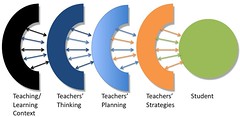Three paths for learning analytics and beyond: moving from rhetoric to reality



| Authors | Colin Beer (CQU), Rolley Tickner (CQU), David Jones (USQ) |
|---|---|
| Publication | Proceedings of ASCILITE2014 |
| Date | 2014 |
| Link | Paper link, Details |
Learning analytics (LA) is a topical area of educational technology research. Many are sure of the potential of learning analytics to improve online and blended learning outcomes. There are a number of small-scale systems being trialled around the world, but the promised benefits of LA are yet to be fully realised, according to this paper presented at ASCILITE in Otago, New Zealand late in November 2014.
Just Over the Horizon
The paper begins by recognising the rhetoric around LA and attributes it to managerial decision making processes, which the authors say are often driven by fads.
Will learning analytics be a repeat of past mistakes where technology implementations fail to move beyond a transitory fad and provide meaningful and sustained contributions to learning and teaching?As evidence, Beer et al note that LA has had some mention in the Horizon Report since 2010. In 2012 LA was declared to be "one year or less" away. Again, in 2014, LA was "one year or less" away. However, in 2014, LA was considered "two to three years" away.
The authors note that adoption requires resolving technical barriers as well as encouraging use.
Three Paths
Beer et al provide three possible ways for "how LA can avoid becoming yet another fad".
- Do it to teachers, where institutional change alters the teaching context.
- Do it for teachers, driven by an alliance of innovative teachers, ICT and vendors.
- Do it with teachers to determine how LA can help in the teaching context.
The authors recommend a balance of the three approaches, including "do it with" as a must for LA projects.
Beer et al back up their view through literature and also go on to describe EASI, an intervention system working towards greater engagement, currently in initial use.
This paper is attached to this post and is worth a read for all researchers and developers working towards LA tools right now. You can also access the slides used in the presentation of this paper at ASCILITE2014.



